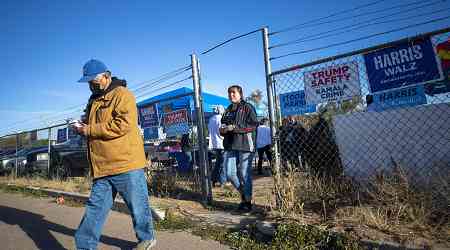
Some may conclude that Donald Trump’s recent conspiratorial demonizing of Democrats, immigrants, Jews, the children of judges across parties, devoted FEMA relief workers, and even wounded U.S. soldiers is evidence of the desperation of a flailing candidate. That would be wrong, as this campaign of conspiracy is a longstanding strategic device. It has always been his goal to be invincible, never admitting errors and vilifying innocent perceived threats. There is a logic to Donald Trump’s dangerous pattern of false vilification which was forecasted in Eric Hoffer’s The True Believer, which revealed the effectiveness of division to fuel mass movements over history.
[time-brightcove not-tgx=”true”]At a campaign rally in Pennsylvania this weekend commemorating his survival from a July assassination attempt there, Donald Trump, Eric Trump, J.D. Vance, and others echoed false accusations that Democrats were responsible for that attack. At the same time, Trump and his allies lobbed false allegations at the Biden/Harris Administration lack of responsiveness to victims of last week’s Hurricane Helene. This despite full-throated praise for FEMA and the Biden/Harris Administration’s rapid response to disaster victims coming from top Republican leaders, from the Governors, Senators, and mayors from the affected states of Georgia, North Carolina, and Tennessee.
Trump employed another vilification of innocent parties during the presidential debate, falsely claiming that illegal Haitian immigrants are snatching neighbors’ pets to kill and eat them. Despite denials from the mayor and town manager of Springfield, Ohio, as well as denials from local residents, local police, and even the Republican Governor of that state; Trump has continued to insist that his foolish embrace of a now-debunked internet hoax was appropriate, and that all town residents and officials disputing him are wrong. This echoed his much-trumpeted indictment of immigrants “poisoning the blood of our country,” quite different from the 1981 Ronald Reagan salute “our nation is a nation of immigrants…our strength comes from our immigrant heritage and our capacity to welcome those from other lands.”
During a New Hampshire political rally in 2015, an attendee yelled out an anti-Muslim slur. I told Trump immediately afterwards on a phone call that by not correcting her, he missed a “McCain Moment” reminding him how Senator John McCain corrected a misguided defamatory Muslim slur directed towards his campaign rival Senator Barack Obama. “Jeff, I don’t care,” he told me. “It’s working, and I can’t say it was a mistake for me to churn things up. Plus, I don’t know how the crowd would react to me.” In 2016, when he falsely attacked the Ford Motor Company for transferring jobs to Mexico, he gave me the same excuse: it’s working.
Throughout his adult life, Trump has preferred to double down on falsehoods over admitting to a mistake—whether his false assertions during his first campaign that Muslims in Jersey City were cheering the Sept. 11, 2001, attack; or his false vilification of “the Central Park Five,” calling for the execution of innocent Black teenagers for a crime proved to be committed by someone else. As one of the loudest voices of the “birther” movement, Trump’s constant lies in peddling conspiracy theories over Barack Obama’s citizenship helped keep him in the headlines even after most Republican voters soured on the issue.
Writing in 1951, Hoffer explained how demagogues trigger mass movements of fear and anger by convincing their followers that their lives have been ruined by “others.” The demagogues convince their followers that they can only redeem their rightful standard of living through bonding together against those “others,” surrendering their individual moral judgement to evaluate the truth to the mobs in a process he called “self-renunciation.” Hoffer explained that such mass movements disparage the present, worship a romanticized image of the past, and project a vague glorification of the future.
Yale historian Timothy Snyder’s new book On Freedom explains how institutions of government can protect human rights while his 2017 book On Tyranny explains how demagogues succeed in eroding those pillars of society to be replaced by a tyrant. In a classic 1964 Harper’s essay, historian Richard Hofstadter warned of the recurrent pattern of apocalyptic and absolutistic frameworks denigrating neighbors and societal institutions with hostility as the paranoid style in American politics.
In Hoffer’s words “The radical and the reactionary loathe the present.” Hoffer insists that such movements require the fabrication of villains even more than they need a god. Two years later, Yale’s mass communication researcher Carl Hovland’s studies showed how the constant repetition of unfounded accusations become as the truth in what he labeled the “sleeper effect.” Seventy years ago, the true believer’s susceptibility to the sleeper effect warned us of the power of Trump’s methods and messages today.






























